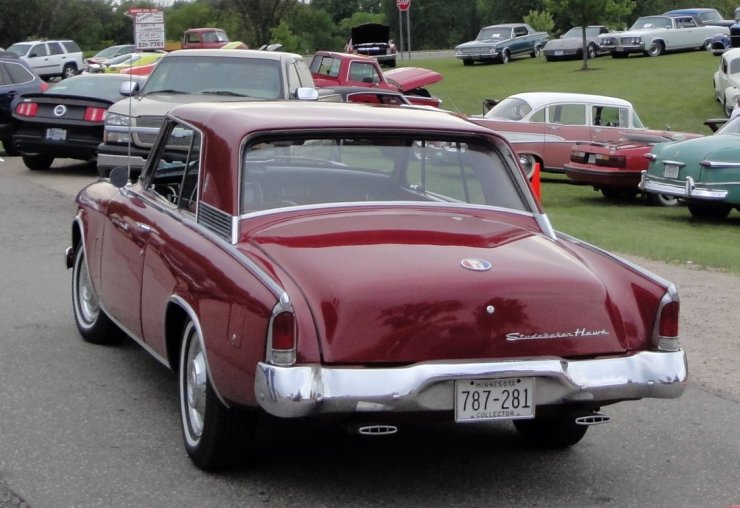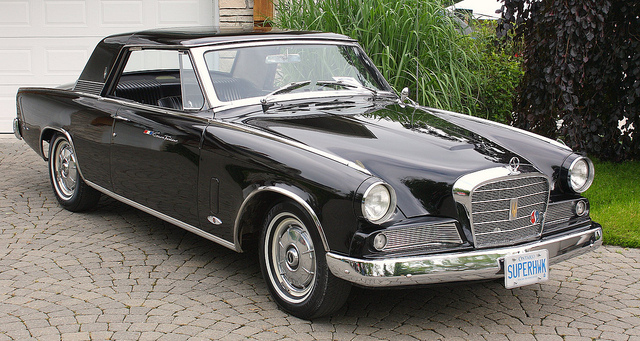Hat tip to Jerry for suggesting this
 The last of the line: a rare 1964 Studebaker Gran Turismo Hawk fitted with the Super Hawk package that included the high-output Avanti engine
The last of the line: a rare 1964 Studebaker Gran Turismo Hawk fitted with the Super Hawk package that included the high-output Avanti engine
Studebaker introduced the Hawk line, based on the body shells of the ’53-’55 Starliner and Starlight coupes, for the 1956 model year. In many ways, the Studebaker coupes paved the way for the “personal luxury coupe” that Ford’s “Squarebird” Thunderbirds, introduced in 1958, are generally given credit for. These Studebaker coupes even set the stage for the Ford Mustang. Two weeks ago, we got a look at the first of the Hawk line when we reviewed the 1956 Golden Hawk.
In its 1956 introductory year, the Hawk series was offered in four models. The base model was the Flight Hawk which was built on the Starlight pillared coupe body shell and powered by the venerable Champion six cylinder engine. Sharing the Flight Hawk’s pillared coupe body was the Power Hawk fitted with the 259 cubic inch Commander V8. Next up on the food chain was the Sky Hawk, built on the “B”-pillar-less Starliner hardtop body shell and fitted with Studebaker’s new-for-1956 289 cubic inch V8. The top of the Hawk line was the Golden Hawk, sharing the Starliner body shell with the Sky Hawk, but trimmed with fins not used on the Sky Hawk – and fitted with the Packard 352 cubic inch V8. The Golden Hawk was the fastest production car of 1956.
Studebaker-Packard poured most of its scarce funds for product development into Studebaker for 1956 in an effort to build volume for the make and stanch the bleeding of capital caused by the high cost, under-utilized Studebaker facilities. But the boom sales year of 1955 did not carry over into 1956, and despite the heavy facelifting across the Studebaker line, sales fell substantially compared to 1955. It didn’t help that the public knew that Studebaker-Packard was struggling and many were afraid of “buying an orphan.”
There was an entirely new line of Studebakers and Packards waiting in the wings for the 1957 model year – IF funding to launch the all new cars could be found. But the funding for the all-new 1957 Studebakers and Packards was not to be found and Packard was forced to close on 26 June, 1956. Defense contractor Curtiss-Wright, eager to pick up Packard’s new Utica, MI engine and transmission plant (which also built Packard’s aircraft and marine engines) and Studebaker’s facilities for defense work, stepped in with a “management contract” that gave Studebaker a bit of breathing room, but mainly benefitted only Curtiss-Wright. Be that as it may, Packard closed and Studebaker fielded cars for 1957 that were facelifted on yet another frayed shoestring of a budget. The Hawk line was pared down to two models, the Silver Hawk, built on the Starlight pillared body shell and another Golden Hawk, built on the Starliner hardtop body shell.
The Silver Hawk was available with the Champion six cylinder engine or the 259 cubic inch V8. The Golden Hawk no longer had the Packard V8 as the Packard engine tooling was not moved to South Bend from Utica, leaving the Studebaker 289 V8 as the largest power plant available. To match the power of the Packard V8 in the Golden Hawk, the 289 was fitted with a McCullough supercharger which brought the engine up to 275 horsepower.
The Golden Hawk got another low-budget, but effective facelift for 1957. The fins were re-styled and some of the trim used on the 1956 Golden Hawks was removed, resulting in a cleaner-lined car.
The 1957 Golden Hawk (above) and the 1957 Silver Hawk (below)
For the 1957 spring selling season, a special Golden Hawk, the 400, was offered. The name was apparently a hit tip to the “400” name used by Packard and the car was fitted with a very nice leather interior. No accurate records were kept of how many of the 400s were built, but the best estimates place the number at around 200 units. Sales suffered again in 1957, not only because of the fears of Studebakers being “orphans,” but also because of the very sharp economic recession of 1957-1958.
With the recession hitting Studebaker hard, there was less money for product development for 1958 than 1957. The Silver Hawk and Golden Hawks were carried over into 1958 with only a minor bit of trim shuffling. There was a Packard Hawk offered for 1958 that retained the supercharger and the 275 horsepower rating of the supercharged 1957 engine. Only 588 Packard Hawks were built.
1958 Studebaker Golden Hawk (above) and Packard Hawk (below)
For 1959, Studebaker saved itself by introducing the Lark compact car. Hit hard by the 1957-1958 recession and paying attention to the success of American Motors Rambler, the growth of economical European imports into the U.S. and the (relative) success of their own Scotsman model for 1957 and 1958, Studebaker launched its compact Lark. Full-size Studebaker Champions, Commanders and Presidents were discontinued. The plan was to discontinue the Hawk as well, but dealers pressured the company into retaining the Hawk for 1959. While the Lark was a success, the 1959 Hawk was not. In one of those maddening decisions Studebaker was infamous for, right at the peak of the hardtop craze, they did not offer the 1959 Hawk in a hardtop. While the body shell was aging, having been introduced in 1953, the body’s graceful lines still looked good, particularly in hardtop form. Thus for 1959, the Silver and Golden names were dropped and the Hawk was offered as an “economy sports coupe” whatever that was supposed to mean. Few of them were sold.
It should have been the hardtop: a 1959 Studebaker Hawk
The story of the 1959 Hawk continued into the 1960 model year with Studebaker offering the Hawk only as the pillared coupe, little changed from 1959.
1960 Hawk
Studebaker stumbled into the 1961 model year by continuing to offer the Hawk only as the pillared coupe. They announced that the Hawk would be limited to 6011 units for the model year. It’s anyones’ guess as to how they came up with the number “6011,” In any case, production was more limited than planned as barely over 3,000 orders were placed. After de-contenting the Hawk for its role as an “economy sports coupe” for 1959 and 1960, the good news about the ’61 Hawks is they got the finned brake drums again and a four speed manual transmission was offered. Mated to the 289 cubic inch V8, the light bodied Hawk with the four speed surprised a lot of Chevy and Ford owners in stop light speed contests. Alas, Studebaker retained the Hawk in the pillared coupe body again for 1961 rather than offering it in the more handsome hardtop.
1961 Studebaker Hawk
Sherwood Egbert had come to Studebaker, chosen by the board to shut down the companies auto operations. Egbert wasn’t a “car guy,” but upon arriving at Studebaker, he quickly became one and determined to go against the board and made a valiant attempt to revitalize the company. It was Egbert who saw to it that the Avanti was launched and it was Egbert who brought in designer Brooks Stevens to restyle the Studebaker passenger cars.
Stevens worked a miracle on the Hawk. He correctly recognized that Studebaker had made a mistake by not continuing the Hawk in hardtop form. He penned what became the 1962 Gran Turismo Hawk hardtop, which was one of the best looking cars of the time and still looks good today. The tacked-on fins were shaved off and the clean Bob Bourke lines of the 1953 Starliner body shell became the basis for the new Gran Turismo Hawk. A new roof, drawing inspiration from Ford’s Thunderbird was fitted. Body trim and taillights similar to the beautiful 1961 Lincoln Continental were added. Studebaker had a new star for its dealer showrooms pending the arrival of the Avanti.
Above and below: the 1962 Gran Truismo Hawk
For 1963, Studebaker’s development money went into the Avanti and (to a lesser extent) the Lark passenger cars, so the 1963 Hawks only got a minor facelift from 1962. However, Avanti power plants and performance goodies were offered. After production of some 9,000 Hawks for 1962, sales fell to little over 4,000 units for 1963.
1963 Gran Turismo Hawk
The 1964 Gran Turismo Hawks got a minor facelift on the front and a new deck lid at the rear. The Super Hawk packages, derived from the Avanti, were continued. Felled by cancer, Egbert was now out at Studebaker. Former Packard executive Byers Burlingame stepped in and did what Egbert wouldn’t: Studebaker ceased production at South Bend on 20 December, 1963. With that came the end of the Avanti and the Gran Turismo Hawk. Only 1,700 ’64 Hawks were built. With the end of Studebaker production at South Bend came the end of the beautiful coupe Robert Bourke had penned for the 1953 model year. The clean, graceful lines of the Starliner/Starlight coupes served Studebaker for twelve model years, culminating in Brooks Stevens’ fine 1964 Gran Turismo Hawk
1964 Studebaker Gran Turismo Hawks
















Bravo! A well done story!
LikeLike
Thank you, “Chris-to-Fear”!
Being that you are a “Studebaker man,” your comment means a lot!
LikeLike
I have always been impressed by Studebaker styles, one of my favorites was the 1939 President, also the Dictator models
LikeLike
hee hee … When Hitler’s intentions became known, Studebaker dropped the “Dictator” name. In any case, it was an odd choice given that the name has never had a positive connotation!
LikeLike
The hawk, a beautiful idea, a great car!
LikeLike
i own a 1936 dictator in an original condition. it is a 2DR slant back sedan with 67000 mi. on the car. the interior is the original one and still look very decent. be fore I acquired the car one if the previous owners repainted the car in the same two shades of green yellowish trim. i love this car and have not found another like it. i saw a four door like it but it was not in the original condition. However I still believe the best looking car ever is the 1955 Studebaker speedster in the lemon/lime color. enjoyed your article thanks JOHN
LikeLike
John, thank you for visiting my blog and for leaving this informative comment!
Each Tuesday I post a new “Gear Head Tuesday.”
Best regards
LikeLike